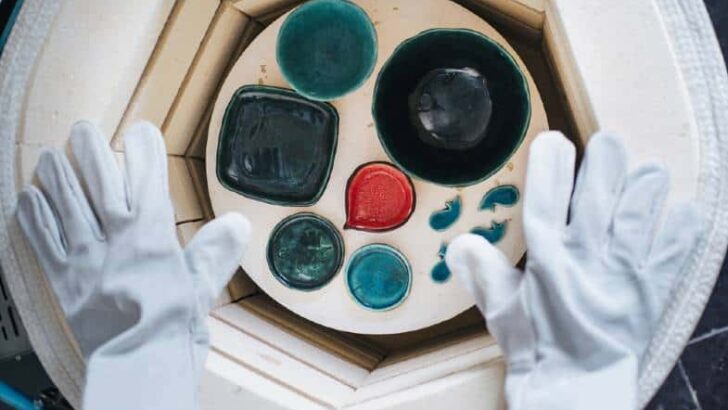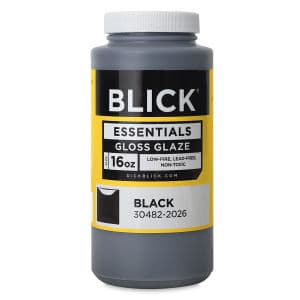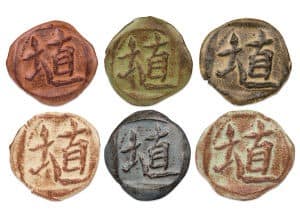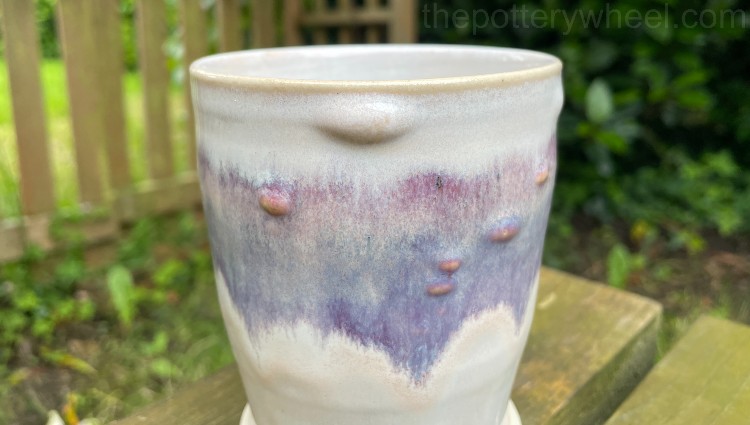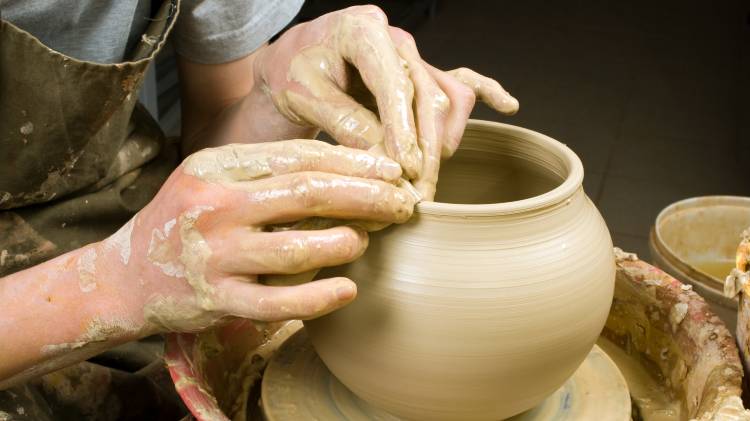Firing clay is the process of turning it from clay into ceramic material. Most of the time pottery is fired twice, and the second firing is called glaze firing. So, what exactly is glaze firing?
The first step in firing pottery is the bisque fire when clay turns into ceramic ware. After the bisque fire, liquid glaze is applied to the pots and allowed to dry. The second firing is the glaze firing, during which the glaze melts to form a glassy coat on the pottery.
So, the glaze firing is the second firing that pottery undergoes, following the bisque fire. During the glaze fire, the glaze and the clay itself undergo a lot of changes. Let’s take a closer look at this process, to get a complete answer to the question of what is glaze firing.
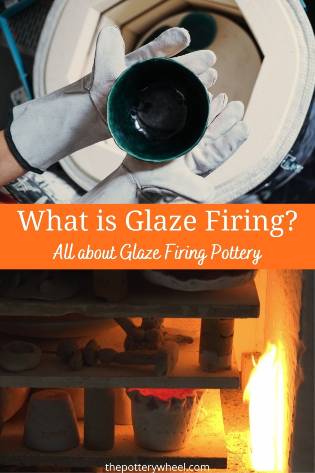
What is Glaze Firing?
The first part of glaze firing involves actually applying the glaze to the pottery.
Glaze Application:
Glaze is normally applied to bisque fired pots. Bisque, also called bisque ware or biscuit ware is clay that has been fired one at around 1832F (1000C). Bisque firing turns raw clay into ceramic pottery, and clay that has been bisque fired is still quite porous.
Before it has been fired, pottery glaze is applied in liquid form to the bisque ware. It can be applied in a few different ways. And the way you glaze your pottery is really a matter of personal preference.
The main ways of applying glaze to pottery are:
- Painting it on
- Dipping the pottery in a bucket of glaze
- Pouring the glaze over the pots
- Spraying the glaze onto the pottery
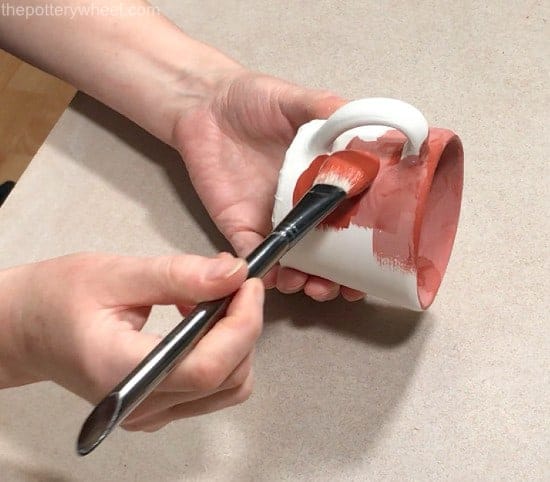
When the glaze is applied, the water from the glaze is drawn out of the liquid by the porous bisque. So, the glaze dries out very quickly. This leaves a powdery dry coating of the glaze material on the pottery surface.
Usually, 2 or 3 coats of glaze are applied to build up the right thickness. However, the number of coats used depends on how the glaze is applied. Normally more layers are applied when brushing the glaze on the pot.
When the glaze has dried on the pot, the pot is ready for glaze firing. To understand what happens to glaze when it’s fired, we need to know what the glaze is made of. So, let’s take a look at that now…
What is Glaze Made Of?
Pottery glaze is made of three main ingredients. They are:
- Silica
- Alumina
- Flux
These are the basic ingredients of a glaze. Other ingredients can be added to adjust the glaze menu. And colorants are added to affect the look of the glazed finish. Here is a brief overview of what these three ingredients do.
Silica
Silica, also known as flint and quartz, is the main glass-forming ingredient in glaze. It is the silica in glaze that creates the liquid glass during firing that goes solid as the pottery cools. This is what forms the glossy, glass-like surface on a glazed pot.
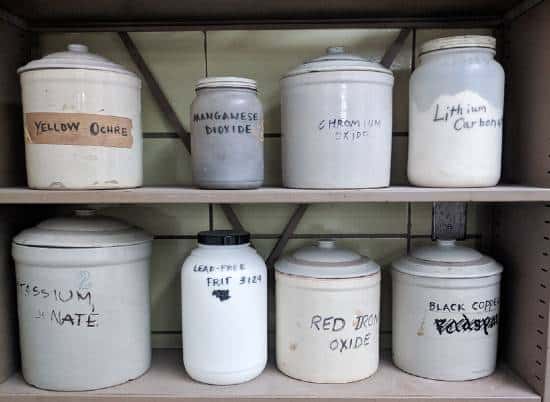
Alumina
Alumina increases the viscosity of the glaze and gives it some body and substance. If glaze didn’t have alumina in it, it would slump off the pottery surface once applied. Alumina helps bulk the glaze out and holds it in place when applied to the pot.
Flux
A flux helps to control the melting point of the glaze when fired. Silica has a high melting point of 3110F (1710C). This is too high to be practical for firing pottery. Flux is used to lower the point at which the silica melts and forms glass.
The ratios of these ingredients, plus any additional materials used will affect how the glaze behaves when it’s fired. It will also affect the temperature at which the glaze melts.
Different Glaze Firing Temperatures
Broadly speaking there are three types of clay for pottery. They are earthenware, stoneware, and porcelain. These different types of clay have different qualities and are fired at different temperatures. Earthenware is fired at lower temperatures than stoneware. And porcelain is usually fired at a higher temperature than stoneware.
The glaze you use needs to melt at the same temperature you are firing your clay at. For that reason, glazes are usually categorized as low fire, mid-fire, or high fire. These categories refer to the temperature range they are suitable for.
What happens during the glaze firing depends to an extent on the type of clay and glaze you are using. And that is what we will cover in the next section…
What Happens During the Glaze Firing?
During the glaze fire, both the clay and the glaze undergo changes. The clay matures and the glaze melts to the clay surface and forming a bond with the clay.
The type of bond the glaze forms with the clay depends upon the temperature that the kiln reaches.
Earthenware Clay
Earthenware clay is low fire clay, which means that it matures at lower temperatures. Clay is said to have matured when it has become as dense and as hard as it can be. Like glaze, clay also contains glass-forming materials.
When clay is fired, glass is formed in the clay body and fills the pores between the clay particles. When the pottery cools the glass becomes solid and makes the clay strong and hard. The more glass-forming materials the clay contains, the harder the fired pottery will be.
Earthenware clay contains a small quantity of glass-forming materials. As a result, earthenware clay is still quite porous once fired. Most of the strength that earthenware clay gets from firing is due to a process of sintering. This is when the surface of the clay particles bonds together and the clay particles move closer to one another.
A lot of these changes take place in earthenware clay during the bisque fire. As a result, earthenware clay does not need to be fired at a higher temperature during the glaze fire.
Earthenware clay has done most of its maturing during the bisque fire. The main purpose of glaze firing earthenware clay is to apply the glaze to the surface of the pottery.
Stoneware Clay
By contrast, stoneware clay does undergo some important changes during glaze firing. As with earthenware clay, the clay particles move closer to one another. In addition to this, the surface of the clay particles sticks to one another.
However, stoneware clay contains more glass-forming materials than earthenware. So, any gaps between the clay particles are filled up with glass. This is called vitrification and it makes stoneware clay non-porous and very hard.
The other difference between earthenware clay and stoneware clay is the type of bond formed between the glaze and clay. Earthenware clay has gone through most of its changes in the bisque fire. So, when it is glazed the glaze melts onto the ceramic surface of the pottery.
By contrast, when stoneware clay is fired, there is more interaction between the glaze and the clay body. They mingle more, and an intermediate layer is formed between the clay and the glaze.
This intermediate interface layer is a mixture of clay and glaze.
This provides a better bond between the clay and the glaze, which have effectively become one.
In spite of the differences between earthenware and stoneware glazes, both types of glaze melt in a glaze firing. So, let’s take a look at some of the changes that happen to glaze as it’s fired….
Melting Glazes
Like clay, glazes also go through a process of sintering. This is one of the first stages in the glaze firing. During the sintering phase, the surface of the glaze particles heats up and becomes soft. At this stage, the glass-forming material in the glaze hasn’t begun to melt. However, the glaze particles have begun to stick together.
The sintered glaze has lost the powdery flakey quality it has when it first dries. But it hasn’t become hot enough to have melted and formed a glossy surface (source).
As the temperature in the kiln increases, the glaze starts to melt and fuse. The structure of the crystals in the glaze materials begins to alter and the glaze begins to become molten.
When the kiln starts to reach its target temperature, the glaze begins to boil. At this point in the firing process, the glaze particles have fused into a liquid and the glaze will bubble.
During this process, the glaze is undergoing chemical and molecular changes and gasses are being released. Once the gasses have escaped the bubbling process calms down and the surface of the glaze smooths out.
If the glaze firing ends too soon, gasses that have not had a chance to escape can get trapped in the glaze. This can cause the glaze to be cloudy or to blister. Potters will sometimes use a soak or hold period at the end of a glaze fire.
During a soak, the kiln is held at a target temperature for a brief period. Usually a few minutes, sometimes longer. The soak provides time for all the gasses that need to escape to have left the glaze.
After this process is complete, the kiln is left to cool. As it cools the glaze forms a hard glassy surface on the pottery.
Final Thoughts
If you’re new to pottery and firing clay, the question ‘what is glaze firing?’ is a reasonable one. There are lots of new terms, processes, and techniques to understand when you get started. I hope this article has helped clarify how glaze firing happens and its purpose. Not only is pottery glaze decorative, but it also provides a protective barrier to pottery.

